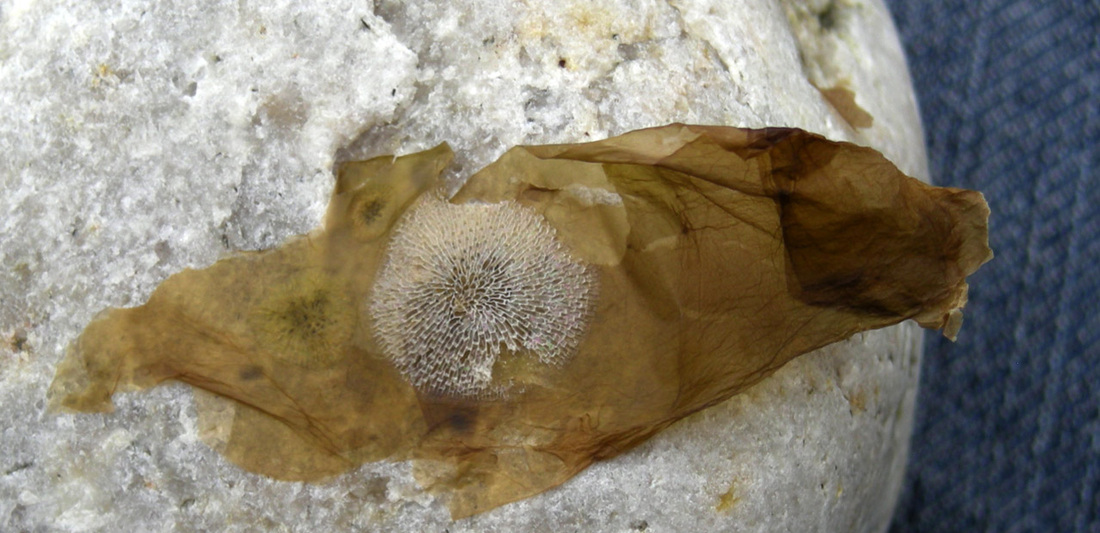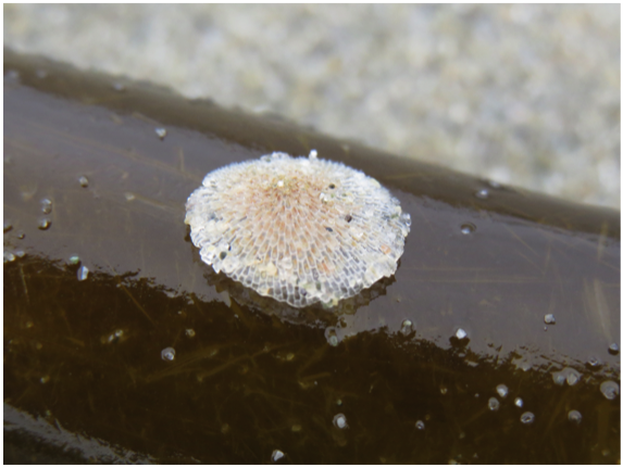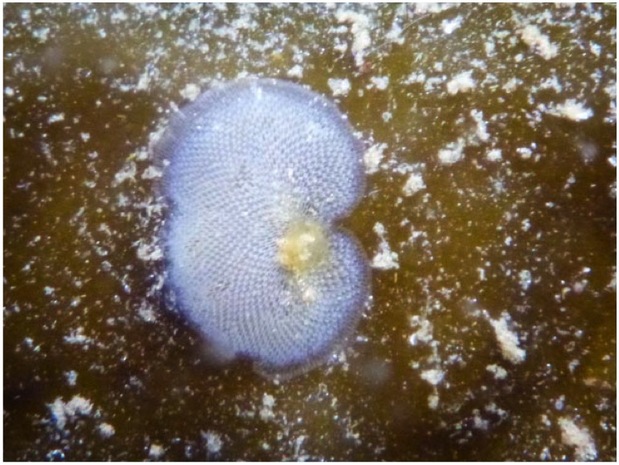Kelp-encrusting bryozoan, kelp lace bryozoan • Membranipora serrilamella, Membranipora membrancea*
Identification
This colonial species resembles a thin white to silver crust. It forms circular patches that grow to 1 mm high and up to 20 cm in diameter. The crust is made up of small rectangular boxes, each of which is an individual animal (called a zooid). Colonial patches often merge together. These rectangles fit together neatly in a radial arrangement, with new growth occurring at the edges.
Habitat & Range
Kelp-encrusting bryozoan grows on kelps and algae to a depth of 180 m, as well as more solid (and inanimate) surfaces like rocks and floats. Its is found from Alaska to Baja California.
Similar Species
The species as currently described may in fact be multiple species. Many bryozoans can only be correctly identified with keys and microscopes. Some photos of unidentified bryozoans listed by Lamb and Hanby show specimens with the same silvery-white crust formation.
Intriguing Info
Kelp-encrusting bryozoan is most commonly seen growing on algae, but when the algal host dies the bryozoan dies as well. Attachment to harder inanimate objects as well as algae is therefore necessary for the species' survival. Colonies grow in size over the summer, and may nearly engulf their algal host. When conditions are right colonies can grow several millimetres in diameter each day. Interactions between colonies can range from cooperative to aggressive as they compete for space.
More information about the life history of this bryozoan can be found on the Race Rocks species page.
* Membranipora membrancea was the original scientific name applied to this species, but this usage was incorrect; it is actually applied (correctly) for a different bryozoan species found in European waters.
This colonial species resembles a thin white to silver crust. It forms circular patches that grow to 1 mm high and up to 20 cm in diameter. The crust is made up of small rectangular boxes, each of which is an individual animal (called a zooid). Colonial patches often merge together. These rectangles fit together neatly in a radial arrangement, with new growth occurring at the edges.
Habitat & Range
Kelp-encrusting bryozoan grows on kelps and algae to a depth of 180 m, as well as more solid (and inanimate) surfaces like rocks and floats. Its is found from Alaska to Baja California.
Similar Species
The species as currently described may in fact be multiple species. Many bryozoans can only be correctly identified with keys and microscopes. Some photos of unidentified bryozoans listed by Lamb and Hanby show specimens with the same silvery-white crust formation.
Intriguing Info
Kelp-encrusting bryozoan is most commonly seen growing on algae, but when the algal host dies the bryozoan dies as well. Attachment to harder inanimate objects as well as algae is therefore necessary for the species' survival. Colonies grow in size over the summer, and may nearly engulf their algal host. When conditions are right colonies can grow several millimetres in diameter each day. Interactions between colonies can range from cooperative to aggressive as they compete for space.
More information about the life history of this bryozoan can be found on the Race Rocks species page.
* Membranipora membrancea was the original scientific name applied to this species, but this usage was incorrect; it is actually applied (correctly) for a different bryozoan species found in European waters.
References
Harbo, R. M. (1999). Whelks to whales: Coastal marine life of the Pacific Northwest. Madeira Park, BC: Harbour Publishing. P. 61.
Lamb, A., and Hanby, B. (2005). Marine Life of the Pacific Northwest [electronic resource]. Madeira Park, BC: Harbour Publishing.
Membranipora serrilamella. The Race Rocks Taxonomy. Lester B. Pearson College. Accessed 16/07/2014.
Authors and editors of page
Kelly Fretwell, Christina Mesckat, and Brian Starzomski (2014).
Harbo, R. M. (1999). Whelks to whales: Coastal marine life of the Pacific Northwest. Madeira Park, BC: Harbour Publishing. P. 61.
Lamb, A., and Hanby, B. (2005). Marine Life of the Pacific Northwest [electronic resource]. Madeira Park, BC: Harbour Publishing.
Membranipora serrilamella. The Race Rocks Taxonomy. Lester B. Pearson College. Accessed 16/07/2014.
Authors and editors of page
Kelly Fretwell, Christina Mesckat, and Brian Starzomski (2014).






